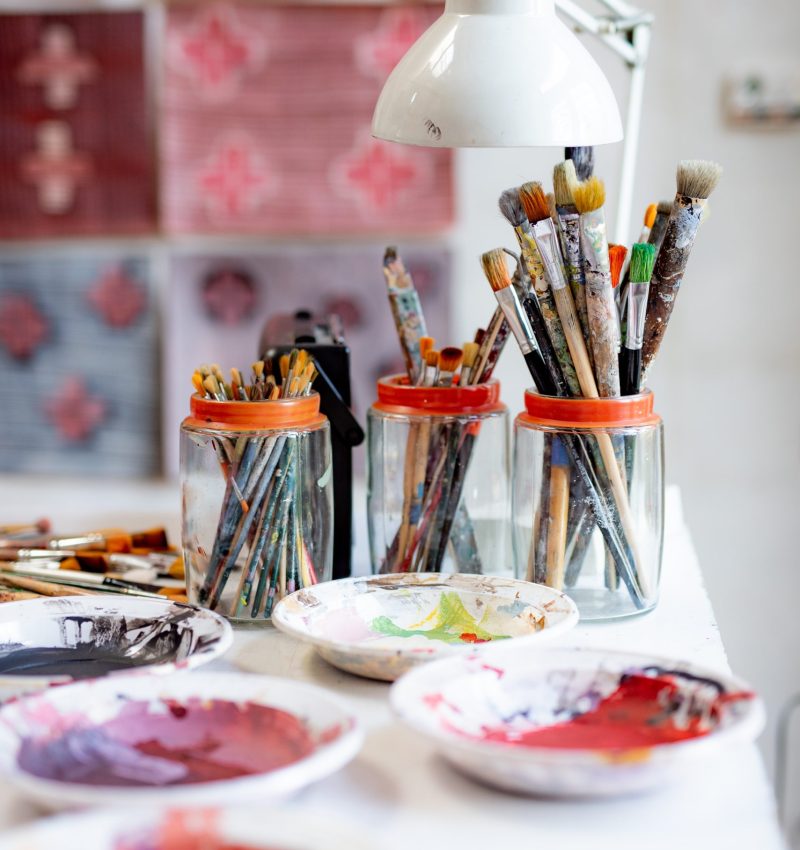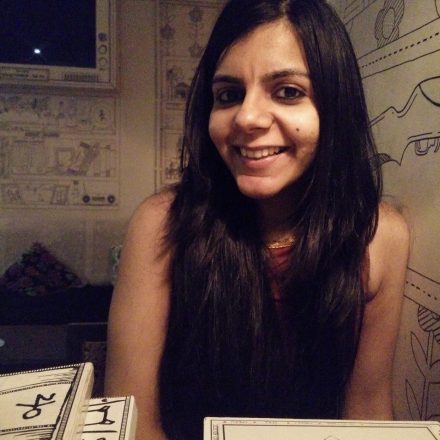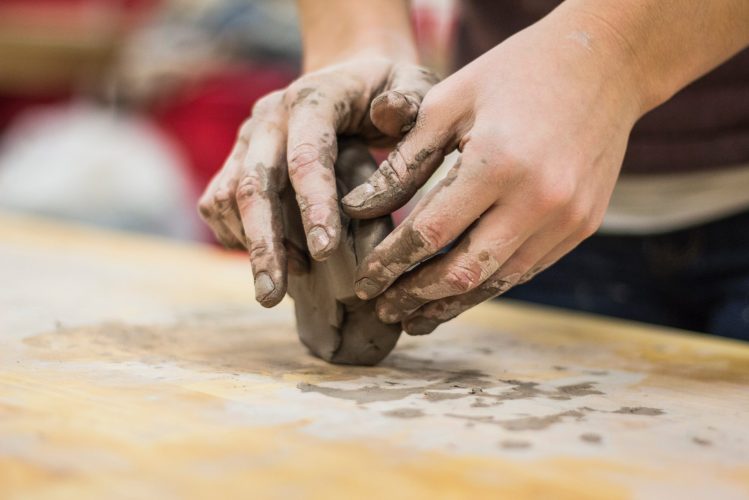Art therapy has the potential to unlock inner resilience and illuminate a path towards personal growth and emotional well-being for individuals of all ages

Art has always been used as a powerful means of expression and communication, serving as a profound channel between our current realities and past encounters. During an enlightening discussion on my podcast, Michal Edree—a specialised art therapist in psychoanalytic or dynamic art therapy, aptly conveys the essence of art therapy as “creating a bridge between the inner world or subconscious and the outer world.” Echoing this sentiment, licensed clinical professional counsellor and registered art therapist— Jennifer Greiner defines it as a “therapeutic process of creating, without necessarily having to use words”.
In recent years, the practice of art therapy has garnered immense popularity as a holistic approach to fostering well-being and promoting overall health. A noteworthy study conducted in 2021 substantiated its efficacy, as a group of four women, each burdened with distinct traumas, reported remarkable improvements in their symptoms as a result of art therapy.
The mechanics
“Three elements remain constant in every session: the client, the artwork they create, and the art therapist.”
Surbhi Khandelwal, Clinical psychologist associate and art therapy practitioner


“Three elements remain constant in every session: the client, the artwork they create, and the art therapist.”
Surbhi Khandelwal, Clinical psychologist associate and art therapy practitioner
Art therapy harnesses the transformative potential of creative expression to enhance mental, emotional, and physical well-being. Surbhi Khandelwal, a clinical psychologist associate and art therapy practitioner, emphasises that “three elements remain constant in every session: the client, the artwork they create, and the art therapist”. Deliberate and thoughtful selection of materials based on their therapeutic effects, coupled with personalised activities tailored to individual needs, showcases the adaptability and beauty of this therapeutic approach. A diverse array of materials finds its way into the process, including colours, paints, clay, thread, shells, old books, and magazines, among others. Additionally, Greiner highlights the critical importance of “assessing where the clients are emotionally, particularly when addressing trauma.” Through such careful guidance, art therapists ensure that their clients transition back into the world in the most empowered and fulfilling manner possible.
Also listen to: Releasing emotional triggers and traumas with Bushra Khan
Empowering children through creativity

“Art is a great way to express [what one has been through or what they are feeling and experiencing] in a way that doesn't feel difficult.”
Jennifer Greiner, Licensed clinical professional counsellor (LCPC) and registered art therapist (ATR)

“Art is a great way to express [what one has been through or what they are feeling and experiencing] in a way that doesn't feel difficult.”
Jennifer Greiner, Licensed clinical professional counsellor (LCPC) and registered art therapist (ATR)
Art therapy serves as a powerful means of addressing children’s struggles with emotional communication, which can often manifest as behavioural challenges. By closely collaborating with art therapists, children are provided with a nurturing environment to express their challenges and tap into their imagination in a way that is uniquely their own. Preferences for specific art materials and the exploration of themes or topics allow for individualised expression.
As Edree points out, art is a “second language for children”; it enables them to freely experiment with different materials. Drawing from her experience, Greiner highlights that children often lack the verbal capacity to communicate their experiences and emotions; making art “a great way to express that, in a way that doesn’t feel difficult”. Art provides a non-intimidating avenue for children to develop coping skills, and alleviate anxiety related to trauma or illness.
Interestingly, research in 2023 demonstrated the positive impact of group drawing art therapy (GDAT) on adolescents and children diagnosed with osteosarcoma, a form of bone cancer, further emphasising the value of art therapy in supporting young individuals facing health issues.
Revitalising ageing adults

It’s not just kids who stand to benefit. As we navigate the complexities of ageing, we encounter various physical and emotional hurdles such as chronic health conditions, social isolation, and cognitive decline. Art therapy emerges as a powerful tool to address these issues, while also nurturing cognitive function. A compelling 2023 study revealed the effectiveness of art therapy in managing psychological symptoms among stroke patients.
When engaging in art therapy, older adults’ unique needs and physical limitations are taken into careful consideration by experts. Edree highlights that adults often harbour self-critical beliefs and feel inexperienced. However, in the realm of art therapy, prior knowledge is not a prerequisite. In fact, Edree suggests, “the less you know, the better you are, because you may have much more freedom [during the process]”.
“Art therapy creates a room for self-expression. With not everyone having the gift of gab, it helps those who struggle to express themselves verbally to feel like their thoughts are being read— in turn feeling heard and seen,” adds art writer, researcher, and curator Reema Gehi Desai. In line with this, Khandelwal highlights that art therapy operates on “both the body and mind levels”, and in synergy with other therapies, providing holistic benefits like:

It’s not just kids who stand to benefit. As we navigate the complexities of ageing, we encounter various physical and emotional hurdles such as chronic health conditions, social isolation, and cognitive decline. Art therapy emerges as a powerful tool to address these issues, while also nurturing cognitive function. A compelling 2023 study revealed the effectiveness of art therapy in managing psychological symptoms among stroke patients.
When engaging in art therapy, older adults’ unique needs and physical limitations are taken into careful consideration by experts. Edree highlights that adults often harbour self-critical beliefs and feel inexperienced. However, in the realm of art therapy, prior knowledge is not a prerequisite. In fact, Edree suggests, “the less you know, the better you are, because you may have much more freedom [during the process]”.
“Art therapy creates a room for self-expression. With not everyone having the gift of gab, it helps those who struggle to express themselves verbally to feel like their thoughts are being read— in turn feeling heard and seen,” adds art writer, researcher, and curator Reema Gehi Desai. In line with this, Khandelwal highlights that art therapy operates on “both the body and mind levels”, and in synergy with other therapies, providing holistic benefits like:
1. Reducing stress and anxiety
“Art therapy is a cathartic experience, irrespective of your skill, that helps express your inner thoughts and feelings.”
Reema Gehi Desai, Art writer, researcher and curator


“Art therapy is a cathartic experience, irrespective of your skill, that helps express your inner thoughts and feelings.”
Reema Gehi Desai, Art writer, researcher and curator
Desai beautifully describes art therapy as a “cathartic experience, irrespective of your skill, that helps express your inner thoughts and feelings.” Engaging in the act of creating art itself induces a calming and meditative state, facilitating the release of stress and anxiety.
Meanwhile, Greiner employs art therapy as a means to personify anxiety, offering a tangible representation for her clients. For instance, one of her clients named their anxiety ‘booger’, and used clay to create a sculpture that they would often laugh at. She said that through this, the client was able to perceive anxiety as something less intimidating and controlling, gaining separation from the overwhelming feeling. In 2023, a study noted that art therapy effectively addresses trauma by addressing the nonverbal memories encoded within the body and brain.
2. Improving mood
In a 2022 study, the combination of art therapy with pharmacotherapy was seen to produce remarkable outcomes, significantly reducing depressive symptoms compared to pharmacotherapy alone. Another research highlighted the potential positive impact of art therapy when facilitated by professional art therapists or artists on the quality of life for adults with cancer: it showed improvements in the overall mood of patients.
3. Increasing self-esteem and self-awareness

Art therapy, guided by compassionate professionals, cultivates a safe and non-judgmental haven where patients can freely explore their inner world. Through the creative process, individuals embark on a journey of self-discovery, gaining profound insights into their thoughts and emotions, leading to a sense of self-acceptance. Particularly impactful for those with low self-esteem, a 2023 study highlights the invaluable role of art therapy in secure care environments. Over a span of 12 weeks, individual art therapy sessions generated a remarkable 29% increase in youth hope and a 16% boost in resilience.
4. Enhancing cognitive functioning
Art therapy serves as a facilitator, stimulating diverse areas of the brain and promoting neural connections, resulting in enhanced cognitive functioning. Engaging in artistic activities demands attention, memory, and problem-solving skills, all of which are fortified through art therapy. Moreover, art therapy nurtures fine motor skills and hand-eye coordination, further supporting cognitive development. It’s no wonder that in a notable 2023 study encompassing six art therapy modalities alongside usual care, distinct advantages were observed in improving cognitive function, alleviating agitation-related behaviour, and enhancing overall quality of life.
Also listen to: Lettering and brain function with Sanjana Chatlani
5. Promoting emotional healing

“It’s a huge release when you see an image and say, oh my god, this [feeling] was inside me for so many years; now I can talk about it.”
Michal Edree, Art therapist

“It’s a huge release when you see an image and say, oh my god, this [feeling] was inside me for so many years; now I can talk about it.”
Michal Edree, Art therapist
Edree points out that individuals often have defences that make it challenging to verbalise trauma, abuse, or painful memories from the past, adding that “it’s a huge release when you see an image and say, oh my god, this [feeling] was inside me for so many years; now I can talk about it”.
To this, Desai adds it’s an intriguing aspect of colour interpretation, that different hues represent various facets of one’s emotional state. Having engaged in art therapy alongside other psychic modalities, she shares that they were “guided to work intuitively”, establishing meaningful connections between colours and their emotional states. For instance, while red is typically associated with danger or anger, art therapy facilitates the realisation that it can also signify love, depending on the individual and their unique experience. By engaging with colours intuitively, art therapy offers a powerful means of self-expression and self-discovery.
Colour interpretation has the power to reveal the multifaceted nature of our emotions. This can help us to understand why some colours hold some significance and why they evoke certain emotions – all of this, naturally, links back to each individual’s unique experiences. Art therapy, thus, provides a transformative platform for exploring these connections, fostering healing, and gaining insight into one’s emotional landscape. Through this creative process, individuals can find new perspectives, enhance self-awareness, and navigate their emotional journeys with greater clarity and understanding.
Watch my podcast to discover how art therapy can pave the way towards self-discovery.

